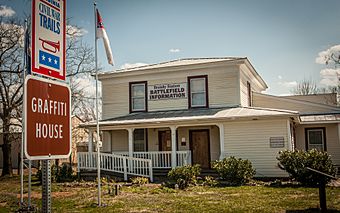Graffiti House facts for kids
|
Graffiti House
|
|
 |
|
| Location | 19484 Brandy Rd., Brandy Station, Virginia |
|---|---|
| Area | less than one acre |
| Built | 1862 |
| Architectural style | Greek Revival |
| MPS | Civil War in Virginia MPS |
| NRHP reference No. | 05001274 |
Quick facts for kids Significant dates |
|
| Added to NRHP | November 17, 2005 |
Imagine a house where soldiers from a long-ago war left their marks on the walls! That's the Graffiti House in Brandy Station, Virginia. It's a special old building that was probably built in 1858. This house is one of the few buildings from before the American Civil War that is still standing today. What makes it so unique are the drawings, names, and messages left by soldiers on its walls. These marks tell stories from a very important time in history.
Contents
Discovering the Graffiti House's Past
The Graffiti House stands near the old Orange & Alexandria Railroad and Carolina Road. It was less than a quarter-mile from the train station. Because of this great location, people think it was a business and a home. Many old drawings and writings have been found on its walls. Some graffiti has been lost over time, but lots of it remains. New messages were even found as recently as December 2010.
During the Civil War, James Barbour owned the house. His main home was a bit further away. That larger home was used by Confederate General J.E.B. Stuart. James Barbour himself worked for Lieutenant General Richard S. Ewell for a time.
A Strategic Spot During the Civil War
The house's location near the railroad was very important. Both the Union Army and Confederate States Army used it often. Confederate soldiers used it as a hospital during the Battle of Brandy Station. They also used it when other battles happened nearby. It likely served as a hospital for wounded soldiers after the Battle of First Bull Run. The oldest graffiti found dates back to August 1862. This was during the Second Manassas Campaign when armies moved through Culpeper County.
Major Battles and Occupations
The biggest cavalry battle in North America happened right next to the Graffiti House. This was the Battle of Brandy Station on June 9, 1863. After the fighting, the house became a Confederate hospital. Later that year, Union troops moved in. This was when the Army of the Potomac camped in Culpeper County.
The house became headquarters for Brigadier General Henry Prince. He was a commander in the Union Army. This was during the Union's chase of the Army of Northern Virginia. This chase happened after the Battle of Gettysburg. It was also used during the Mine Run Campaign in late 1863.
Uncovering Hidden Messages
The second floor of the house has amazing drawings and writings. Soldiers from both sides used charcoal and pencils to leave their marks. They wrote their names and drew pictures of people. They also wrote about their army units and battles. After the war, new paint and wallpaper covered these messages. People forgot about them for many years.
The graffiti was found again during a renovation in 1993. The Brandy Station Foundation bought the house in 2002. Today, the house has a small museum. It also serves as a visitor center for the Brandy Station battlefield. You can visit the house on certain days to see these incredible historical messages.
Who Left Their Mark? Identified Soldiers
Many soldiers left their names and units on the walls. Here are some of the people who have been identified:
- Sergeant Allen Bowman, Co. E, 12th Virginia Cavalry
- Private Michael Bowman, Co. H 7th Virginia Cavalry
- Private Hamilton Boyd, Breathed's Battery, Stuart Horse Artillery
- Private George Washington Butt, Norfolk Light Artillery (Huger's Battery)
- Private James A. J. Cooper, Co. A, 35th Battalion Virginia Cavalry (White's Comanche's)
- Captain Edwin Dillingham, 10th Vermont Infantry
- Private C. Benton Evans, Breathed's Battery, Stuart Horse Artillery
- Private William Evans, Breathed's Battery, Stuart Horse Artillery
- Colonel John Egbert Farnum, Commander, 70th New York Infantry
- Lieutenant Lyman C. Gale, Co. K, 10th Vermont Infantry
- Corporal Fayette Gibson, Breathed's Battery, Stuart Horse Artillery
- Private Thomas 'Herb' Greenwell, Breathed's Battery, Stuart Horse Artillery
- Private Uriah Haller, Breathed's Battery, Stuart Horse Artillery
- Private William J. Haney, 24th Battalion Virginia Partisan Rangers
- Private Henry 'Hal' Hopkins, Breathed's Battery, Stuart Horse Artillery
- Private William Hopkins, Breathed's Battery, Stuart Horse Artillery
- Private Bob Lewis, Norfolk Light Artillery (Huger's Battery)
- Private George McCabe Jr., Breathed's Battery, Stuart Horse Artillery
- Lieutenant William J. Marshall, Co. E, 12th Virginia Cavalry
- Lieutenant Joseph Moore, Norfolk Light Artillery (Huger's Battery)
- Private Edward Moreland, Norfolk Light Artillery (Huger's Battery)
- Private A Muth, Breathed's Battery, Stuart Horse Artillery
- Private George W. Orrison, Co. C, 35th Battalion Virginia Cavalry (White's Comanche's)
- Private David Owens, Breathed's Battery, Stuart Horse Artillery
- Private Robert Peed, Norfolk Light Artillery (Huger's Battery)
- Private David Owens, Breathed's Battery, Stuart Horse Artillery
- Private Dan Quinlan, Massachusetts Light Battery 'C'
- Private Elijah Russell, Breathed's Battery, Stuart Horse Artillery
- Maj. Gen. J.E.B. Stuart, Commander, Army of Northern Virginia Cavalry
- Sergeant Henry Thomas, Breathed's Battery, Stuart Horse Artillery
- Private Harry Wagner, Breathed's Battery, Stuart Horse Artillery
- Private Harry Wickes, Breathed's Battery, Stuart Horse Artillery
- Private Thomas 'Frank' Yates, Breathed's Battery, Stuart Horse Artillery
Mysterious Signatures: Unidentified Graffiti
Some names found on the walls have not yet been linked to specific soldiers. These mysterious signatures add to the house's history:
- Lewis Metta
- Frank E. Kelly
- M Rown
- T.E. Kelly
- Emanuel
- A.L. Brynn
Images for kids
See also







